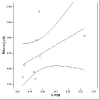Evidence from in vivo 31-phosphorus magnetic resonance spectroscopy phosphodiesters that exhaled ethane is a biomarker of cerebral n-3 polyunsaturated fatty acid peroxidation in humans
- PMID: 18433512
- PMCID: PMC2330077
- DOI: 10.1186/1471-244X-8-S1-S2
Evidence from in vivo 31-phosphorus magnetic resonance spectroscopy phosphodiesters that exhaled ethane is a biomarker of cerebral n-3 polyunsaturated fatty acid peroxidation in humans
Abstract
Background: This study tested the hypothesis that exhaled ethane is a biomarker of cerebral n-3 polyunsaturated fatty acid peroxidation in humans. Ethane is released specifically following peroxidation of n-3 polyunsaturated fatty acids. We reasoned that the cerebral source of ethane would be the docosahexaenoic acid component of membrane phospholipids. Breakdown of the latter also releases phosphorylated polar head groups, giving rise to glycerophosphorylcholine and glycerophosphorylethanolamine, which can be measured from the 31-phosphorus neurospectroscopy phosphodiester peak. Schizophrenia patients were chosen because of evidence of increased free radical-mediated damage and cerebral lipid peroxidation in this disorder.
Methods: Samples of alveolar air were obtained from eight patients and ethane was analyzed and quantified by gas chromatography and mass spectrometry (m/z = 30). Cerebral 31-phosphorus spectra were obtained from the same patients at a magnetic field strength of 1.5 T using an image-selected in vivo spectroscopy sequence (TR = 10 s; 64 signal averages localized on a 70 x 70 x 70 mm3 voxel). The quantification of the 31-phosphorus signals using prior knowledge was carried out in the temporal domain after truncating the first 1.92 ms of the signal to remove the broad component present in the 31-phosphorus spectra.
Results: The ethane and phosphodiester levels, expressed as a percentage of the total 31-phosphorus signal, were positively and significantly correlated (rs = 0.714, p < 0.05).
Conclusion: Our results support the hypothesis that the measurement of exhaled ethane levels indexes cerebral n-3 lipid peroxidation. From a practical viewpoint, if human cerebral n-3 polyunsaturated fatty acid catabolism can be measured by ethane in expired breath, this would be more convenient than determining the area of the 31-phosphorus neurospectroscopy phosphodiester peak.
Figures
Similar articles
-
Cerebral spectroscopic and oxidative stress studies in patients with schizophrenia who have dangerously violently offended.BMC Psychiatry. 2008 Apr 17;8 Suppl 1(Suppl 1):S7. doi: 10.1186/1471-244X-8-S1-S7. BMC Psychiatry. 2008. PMID: 18433517 Free PMC article.
-
Indexation of cerebral cell membrane phospholipid catabolism by the non-invasively determined cerebral 31-phosphorus neurospectroscopic phosphodiester peak.Med Hypotheses. 2012 Feb;78(2):312-4. doi: 10.1016/j.mehy.2011.11.010. Epub 2011 Dec 2. Med Hypotheses. 2012. PMID: 22136945
-
Proton and 31-phosphorus neurospectroscopy in the study of membrane phospholipids and fatty acid intervention in schizophrenia, depression, chronic fatigue syndrome (myalgic encephalomyelitis) and dyslexia.Int Rev Psychiatry. 2006 Apr;18(2):145-7. doi: 10.1080/09540260600581852. Int Rev Psychiatry. 2006. PMID: 16777668 Review.
-
A comparison of oxidative stress in smokers and non-smokers: an in vivo human quantitative study of n-3 lipid peroxidation.BMC Psychiatry. 2008 Apr 17;8 Suppl 1(Suppl 1):S4. doi: 10.1186/1471-244X-8-S1-S4. BMC Psychiatry. 2008. PMID: 18433514 Free PMC article.
-
The potential of the hydrocarbon breath test as a measure of lipid peroxidation.Free Radic Biol Med. 1994 Aug;17(2):127-60. doi: 10.1016/0891-5849(94)90110-4. Free Radic Biol Med. 1994. PMID: 7959173 Review.
Cited by
-
Antioxidants, redox signaling, and pathophysiology in schizophrenia: an integrative view.Antioxid Redox Signal. 2011 Oct 1;15(7):2011-35. doi: 10.1089/ars.2010.3603. Epub 2011 Apr 21. Antioxid Redox Signal. 2011. PMID: 21126177 Free PMC article. Review.
-
Applications of Near Infrared Photoacoustic Spectroscopy for Analysis of Human Respiration: A Review.Molecules. 2020 Apr 9;25(7):1728. doi: 10.3390/molecules25071728. Molecules. 2020. PMID: 32283766 Free PMC article. Review.
-
Cerebral spectroscopic and oxidative stress studies in patients with schizophrenia who have dangerously violently offended.BMC Psychiatry. 2008 Apr 17;8 Suppl 1(Suppl 1):S7. doi: 10.1186/1471-244X-8-S1-S7. BMC Psychiatry. 2008. PMID: 18433517 Free PMC article.
-
Fatty acids and neuropsychiatric disorders.BMC Psychiatry. 2008 Apr 17;8 Suppl 1(Suppl 1):S1. doi: 10.1186/1471-244X-8-S1-S1. BMC Psychiatry. 2008. PMID: 18433511 Free PMC article. No abstract available.
References
-
- Halliwell B, Gutteridge JMC. Free Radicals in Biology and Medicine. 4. Oxford: Oxford University Press; 2007.
-
- Cohen G. Oxy-radical toxicity in catecholamine neurons. Neurotoxicology. 1984;5:77–82. - PubMed
MeSH terms
Substances
LinkOut - more resources
Full Text Sources
Medical


